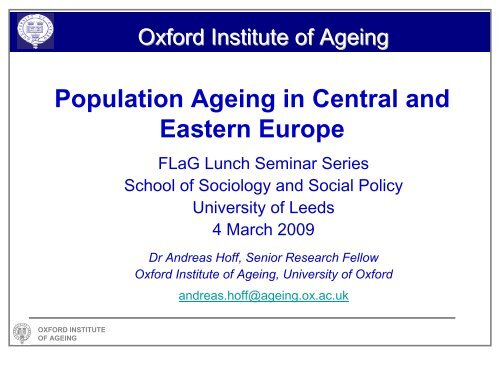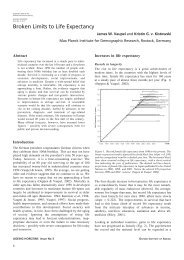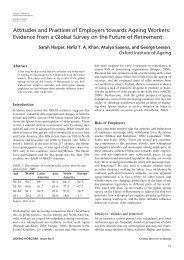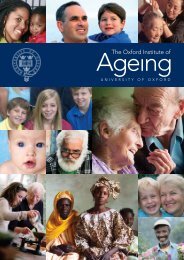Population Ageing in Central and Eastern Europe - Oxford Institute ...
Population Ageing in Central and Eastern Europe - Oxford Institute ...
Population Ageing in Central and Eastern Europe - Oxford Institute ...
You also want an ePaper? Increase the reach of your titles
YUMPU automatically turns print PDFs into web optimized ePapers that Google loves.
<strong>Oxford</strong> <strong>Institute</strong> of <strong>Age<strong>in</strong>g</strong><br />
<strong>Population</strong> <strong>Age<strong>in</strong>g</strong> <strong>in</strong> <strong>Central</strong> <strong>and</strong><br />
<strong>Eastern</strong> <strong>Europe</strong><br />
FLaG Lunch Sem<strong>in</strong>ar Series<br />
School of Sociology <strong>and</strong> Social Policy<br />
University of Leeds<br />
4 March 2009<br />
Dr Andreas Hoff, Senior Research Fellow<br />
<strong>Oxford</strong> <strong>Institute</strong> of <strong>Age<strong>in</strong>g</strong>, University of <strong>Oxford</strong><br />
<strong>and</strong>reas.hoff@age<strong>in</strong>g.ox.ac.uk<br />
OXFORD INSTITUTE<br />
OF AGEING
<strong>Oxford</strong> <strong>Institute</strong> of <strong>Age<strong>in</strong>g</strong><br />
Outl<strong>in</strong>e<br />
1. Introduction: <strong>Central</strong> <strong>and</strong> <strong>Eastern</strong> <strong>Europe</strong>’s transition from socialist to<br />
age<strong>in</strong>g societies<br />
2. The relationship between socio-economic crisis <strong>and</strong> demographic<br />
change<br />
3. The drivers of population age<strong>in</strong>g <strong>in</strong> <strong>Central</strong> <strong>and</strong> <strong>Eastern</strong> <strong>Europe</strong><br />
4. Result<strong>in</strong>g effects on the population structure <strong>in</strong> <strong>Central</strong> <strong>and</strong> <strong>Eastern</strong><br />
<strong>Europe</strong><br />
5. Conclusions: Implications of population age<strong>in</strong>g for the CEE societies<br />
Source: Hoff, A. (2008): <strong>Population</strong> <strong>Age<strong>in</strong>g</strong> <strong>in</strong> <strong>Central</strong> <strong>and</strong> <strong>Eastern</strong> <strong>Europe</strong> as an Outcome of<br />
the Socio-economic Transition to Capitalism. Social<strong>in</strong>is darbas [Lithuanian Journal of<br />
Social Work], 8(2): 14-25.<br />
OXFORD INSTITUTE<br />
OF AGEING
<strong>Oxford</strong> <strong>Institute</strong> of <strong>Age<strong>in</strong>g</strong><br />
1.<br />
<strong>Central</strong> <strong>and</strong> <strong>Eastern</strong> <strong>Europe</strong>’s<br />
transition from socialist to<br />
age<strong>in</strong>g societies<br />
OXFORD INSTITUTE<br />
OF AGEING
OXFORD INSTITUTE<br />
OF AGEING<br />
<strong>Oxford</strong> <strong>Institute</strong> of <strong>Age<strong>in</strong>g</strong>
<strong>Oxford</strong> <strong>Institute</strong> of <strong>Age<strong>in</strong>g</strong><br />
<strong>Eastern</strong> <strong>Europe</strong><br />
OXFORD INSTITUTE<br />
OF AGEING
OXFORD INSTITUTE<br />
OF AGEING<br />
<strong>Oxford</strong> <strong>Institute</strong> of <strong>Age<strong>in</strong>g</strong><br />
1. Intro: From ‚Socialist‘ to ‚<strong>Age<strong>in</strong>g</strong>‘ Societies<br />
• 2009 = 20 th Anniversary of the “Velvet Revolution” / “Peaceful<br />
Revolution” <strong>in</strong> <strong>Central</strong> <strong>and</strong> <strong>Eastern</strong> <strong>Europe</strong> (CEE) <strong>in</strong> 1989<br />
• S<strong>in</strong>ce 1989, CEE has been undergo<strong>in</strong>g transformation from ‘statesocialist’<br />
societies / planned economies ‘free’ societies / market<br />
economies<br />
• Rapid process of re-organisation of social <strong>in</strong>stitutions (Worldbank / IMF<br />
‘shock therapy’)<br />
• Their people were unprepared for these changes<br />
• Dramatic changes of people’s lives, <strong>in</strong>clud<strong>in</strong>g:<br />
devaluation of degrees / qualifications<br />
mass unemployment (unemployment previously unknown)<br />
poverty / social exclusion<br />
detoriat<strong>in</strong>g health care provision (former Soviet Union)<br />
widen<strong>in</strong>g gulf between rich <strong>and</strong> poor
OXFORD INSTITUTE<br />
OF AGEING<br />
<strong>Oxford</strong> <strong>Institute</strong> of <strong>Age<strong>in</strong>g</strong><br />
1. Intro: From ‚Socialist‘ to ‚<strong>Age<strong>in</strong>g</strong>‘ Societies (2)<br />
Uncerta<strong>in</strong>ty, <strong>in</strong>security<br />
Did people change their behaviour / take different decisions?<br />
Mass emigration of young <strong>Eastern</strong> <strong>Europe</strong>ans to Western <strong>Europe</strong>, North<br />
America, Australia, etc.<br />
Young people <strong>in</strong> CEE stopped hav<strong>in</strong>g children (postponement)!<br />
Until today, little attention paid to causes of this extraord<strong>in</strong>ary fertility decl<strong>in</strong>e<br />
(Caldwell & Sch<strong>in</strong>dlmayr 2003)<br />
1. Is there population age<strong>in</strong>g <strong>in</strong> CEE?<br />
2. Is there a l<strong>in</strong>k between post-communist transformation <strong>and</strong> population<br />
age<strong>in</strong>g?<br />
This paper argues that population age<strong>in</strong>g <strong>in</strong> <strong>Central</strong> <strong>and</strong> <strong>Eastern</strong> <strong>Europe</strong> is<br />
an (un<strong>in</strong>tended) outcome of the socio-economic <strong>in</strong>security <strong>in</strong> the wake of<br />
the transformation of the CEE planned economies to market economies.
<strong>Oxford</strong> <strong>Institute</strong> of <strong>Age<strong>in</strong>g</strong><br />
2.<br />
The relationship between<br />
socio-economic crisis <strong>and</strong><br />
demographic change<br />
OXFORD INSTITUTE<br />
OF AGEING
OXFORD INSTITUTE<br />
OF AGEING<br />
<strong>Oxford</strong> <strong>Institute</strong> of <strong>Age<strong>in</strong>g</strong>
<strong>Oxford</strong> <strong>Institute</strong> of <strong>Age<strong>in</strong>g</strong><br />
2. Socio-economic crisis <strong>and</strong> demographic change<br />
• Most previous research focused on economic growth as dependent<br />
variable, with demography be<strong>in</strong>g the <strong>in</strong>dependent variable (Bloom,<br />
Cann<strong>in</strong>g & Sevilla 2003)<br />
• Some research evidence <strong>in</strong> developmental studies: economic hardship<br />
results <strong>in</strong> fewer children + lower <strong>in</strong>vestments <strong>in</strong> them (Lesthaeghe 1989;<br />
Eloundou-Enyegue, Stokes & Cornwell 2000)<br />
• Some argued that economic crisis of 1970s encouraged low-fertility<br />
attitudes <strong>in</strong> the US (Teitelbaum & W<strong>in</strong>ter 1985) <strong>and</strong> the UK (Hobcraft<br />
1996)<br />
• Previous studies on decl<strong>in</strong><strong>in</strong>g life expectancy <strong>in</strong> CEE blamed<br />
transformation process (e.g. Witte & Wagner 1995; St<strong>and</strong><strong>in</strong>g 1996;<br />
Holzer & Kowalska 1997; Philipov 2001; Rychterova & Kraus 2001)<br />
OXFORD INSTITUTE<br />
OF AGEING
<strong>Oxford</strong> <strong>Institute</strong> of <strong>Age<strong>in</strong>g</strong><br />
2. Socio-economic crisis <strong>and</strong> demographic change<br />
• Others challenged the assumption that there WAS a prolonged<br />
economic crisis <strong>in</strong> CEE <strong>in</strong> the first place – Maddison (2001) claims lack<br />
of ‘hard economic facts’ prov<strong>in</strong>g prolonged economic crisis <strong>in</strong> the region<br />
• Eurostat evidence is mixed: Czech Republic had lower unemployment<br />
rate than EU15 <strong>in</strong> mid/late 1990s – but clear evidence of ris<strong>in</strong>g<br />
unemployment <strong>in</strong> most CEE countries <strong>and</strong> massive drop <strong>in</strong> GDP<br />
• St<strong>and</strong><strong>in</strong>g (1996) po<strong>in</strong>ted out that CEE lost their 3 ma<strong>in</strong> pillars of<br />
economic security dur<strong>in</strong>g transformation years:<br />
(1) Guaranteed employment from leav<strong>in</strong>g education till retirement<br />
(2) Social protection by means of stable low prices through subsidies<br />
(3) Various enterprise-based <strong>in</strong>-k<strong>in</strong>d benefits (hous<strong>in</strong>g, childcare, health<br />
care; holiday packages)<br />
• What matters for <strong>in</strong>dividual decisions, however, is perceived<br />
OXFORD INSTITUTE<br />
OF AGEING<br />
economic <strong>in</strong>security, not ‘hard facts’
<strong>Oxford</strong> <strong>Institute</strong> of <strong>Age<strong>in</strong>g</strong><br />
3.<br />
The Drivers of<br />
<strong>Population</strong> <strong>Age<strong>in</strong>g</strong><br />
<strong>in</strong> CEE<br />
OXFORD INSTITUTE<br />
OF AGEING
<strong>Oxford</strong> <strong>Institute</strong> of <strong>Age<strong>in</strong>g</strong><br />
Drivers of population age<strong>in</strong>g<br />
1. Mortality<br />
‣ (ris<strong>in</strong>g) life expectancy larger share of older<br />
people<br />
2. Fertility<br />
‣ (decl<strong>in</strong><strong>in</strong>g) birth rates smaller share of<br />
younger people<br />
3. Migration patterns<br />
‣ number <strong>and</strong> age of immigrants/emigrants<br />
OXFORD INSTITUTE<br />
OF AGEING
<strong>Oxford</strong> <strong>Institute</strong> of <strong>Age<strong>in</strong>g</strong><br />
(I)<br />
Mortality (life expectancy)<br />
OXFORD INSTITUTE<br />
OF AGEING
80<br />
75<br />
70<br />
65<br />
60<br />
55<br />
50<br />
<strong>Oxford</strong> <strong>Institute</strong> of <strong>Age<strong>in</strong>g</strong><br />
Male life expectancy at birth<br />
(Eurostat <strong>Population</strong> Statistics 2006)<br />
1960 1970 1980 1990 2000 2004<br />
RUS<br />
EST<br />
LAT<br />
LIT<br />
POL<br />
CZ<br />
SK<br />
HU<br />
SLO<br />
ROM<br />
BUL<br />
CRO<br />
SER<br />
BOS<br />
MAK<br />
ALB<br />
EU15<br />
OXFORD INSTITUTE<br />
OF AGEING
85<br />
80<br />
75<br />
70<br />
65<br />
60<br />
55<br />
OXFORD INSTITUTE<br />
OF AGEING<br />
<strong>Oxford</strong> <strong>Institute</strong> of <strong>Age<strong>in</strong>g</strong><br />
Female life expectancy at birth<br />
(Eurostat <strong>Population</strong> Statistics 2006)<br />
1960 1970 1980 1990 2000 2004<br />
RUS<br />
EST<br />
LAT<br />
LIT<br />
POL<br />
CZ<br />
SK<br />
HU<br />
SLO<br />
ROM<br />
BUL<br />
CRO<br />
SER<br />
BOS<br />
MAK<br />
ALB<br />
EU15
<strong>Oxford</strong> <strong>Institute</strong> of <strong>Age<strong>in</strong>g</strong><br />
(II)<br />
Fertility<br />
OXFORD INSTITUTE<br />
OF AGEING
3.1<br />
2.9<br />
2.7<br />
2.5<br />
2.3<br />
2.1<br />
1.9<br />
1.7<br />
1.5<br />
1.3<br />
1.1<br />
<strong>Oxford</strong> <strong>Institute</strong> of <strong>Age<strong>in</strong>g</strong><br />
Total fertility rates<br />
(Eurostat <strong>Population</strong> Statistics 2006)<br />
1960 1970 1980 1990 2000 2004<br />
RUS<br />
EST<br />
LAT<br />
LIT<br />
POL<br />
CZ<br />
SK<br />
HU<br />
SLO<br />
ROM<br />
BUL<br />
CRO<br />
SER<br />
BOS<br />
MAK<br />
ALB<br />
EU15<br />
OXFORD INSTITUTE<br />
OF AGEING
<strong>Oxford</strong> <strong>Institute</strong> of <strong>Age<strong>in</strong>g</strong><br />
(III)<br />
Migration<br />
OXFORD INSTITUTE<br />
OF AGEING
<strong>Oxford</strong> <strong>Institute</strong> of <strong>Age<strong>in</strong>g</strong><br />
Nature <strong>and</strong> age structure of migration<br />
Emigration<br />
Immigration<br />
Young migrants A B<br />
Old migrants C D<br />
OXFORD INSTITUTE<br />
OF AGEING
<strong>Oxford</strong> <strong>Institute</strong> of <strong>Age<strong>in</strong>g</strong><br />
Net migration (+ immigration, - emigration)<br />
(Eurostat <strong>Population</strong> Statistics 2006)<br />
600<br />
500<br />
400<br />
300<br />
200<br />
100<br />
0<br />
-100<br />
-200<br />
-300<br />
-400<br />
-500<br />
1960/64 1970/74 1980/84 1990/94 2000 2004<br />
EU25 GER FR ITA POL SWE UK<br />
OXFORD INSTITUTE<br />
OF AGEING
<strong>Oxford</strong> <strong>Institute</strong> of <strong>Age<strong>in</strong>g</strong><br />
Net migration (+ immigration, - emigration)<br />
(Eurostat <strong>Population</strong> Statistics 2006)<br />
Percentage<br />
50<br />
0<br />
-50<br />
-100<br />
-150<br />
-200<br />
-250<br />
-300<br />
-350<br />
-400<br />
-450<br />
1960/64 1970/74 1980/84 1990/94 2000 2004<br />
CZ ROM LIT LAT POL CRO HU BUL<br />
OXFORD INSTITUTE<br />
OF AGEING
<strong>Oxford</strong> <strong>Institute</strong> of <strong>Age<strong>in</strong>g</strong><br />
4.<br />
Result<strong>in</strong>g Effects on the<br />
<strong>Population</strong> Structure<br />
<strong>in</strong> CEE<br />
OXFORD INSTITUTE<br />
OF AGEING
<strong>Oxford</strong> <strong>Institute</strong> of <strong>Age<strong>in</strong>g</strong><br />
(I)<br />
<strong>Population</strong> share of older people<br />
• Percentage of total population aged 60+<br />
OXFORD INSTITUTE<br />
OF AGEING
25<br />
20<br />
15<br />
10<br />
5<br />
<strong>Oxford</strong> <strong>Institute</strong> of <strong>Age<strong>in</strong>g</strong><br />
Proportion of 60+<br />
(Eurostat <strong>Population</strong> Statistics 2006)<br />
1960 1970 1980 1990 2000 2005<br />
RUS<br />
EST<br />
LAT<br />
LIT<br />
POL<br />
CZ<br />
SK<br />
HU<br />
SLO<br />
ROM<br />
BUL<br />
CRO<br />
SER<br />
BOS<br />
MAK<br />
ALB<br />
EU15<br />
OXFORD INSTITUTE<br />
OF AGEING
<strong>Oxford</strong> <strong>Institute</strong> of <strong>Age<strong>in</strong>g</strong><br />
(II)<br />
Old-age dependency ratio<br />
= number of 65+ per 100 aged 15-64<br />
OXFORD INSTITUTE<br />
OF AGEING
60<br />
50<br />
40<br />
30<br />
20<br />
10<br />
<strong>Oxford</strong> <strong>Institute</strong> of <strong>Age<strong>in</strong>g</strong><br />
Old-age dependency ratio (Eurostat 2005)<br />
1995 2005 2015 2025 2035 2045<br />
EST<br />
LAT<br />
LIT<br />
POL<br />
CZ<br />
SK<br />
HU<br />
SLO<br />
ROM<br />
BUL<br />
EU15<br />
OXFORD INSTITUTE<br />
OF AGEING
OXFORD INSTITUTE<br />
OF AGEING<br />
<strong>Oxford</strong> <strong>Institute</strong> of <strong>Age<strong>in</strong>g</strong>
<strong>Oxford</strong> <strong>Institute</strong> of <strong>Age<strong>in</strong>g</strong><br />
5.<br />
Implications of<br />
population age<strong>in</strong>g for the<br />
CEE societies<br />
OXFORD INSTITUTE<br />
OF AGEING
<strong>Oxford</strong> <strong>Institute</strong> of <strong>Age<strong>in</strong>g</strong><br />
Conclusions<br />
This paper argued that population age<strong>in</strong>g <strong>in</strong> <strong>Central</strong> <strong>and</strong> <strong>Eastern</strong><br />
<strong>Europe</strong> is an outcome of the socio-economic <strong>in</strong>security follow<strong>in</strong>g<br />
the economic crisis accompany<strong>in</strong>g the transformation of the CEE<br />
planned economies to market economies.<br />
• It was provided evidence that CEE populations are age<strong>in</strong>g too<br />
• It was made the case that population age<strong>in</strong>g is likely to be the aggregate<br />
outcome of <strong>in</strong>dividual decisions to postpone child birth + to move abroad<br />
<strong>in</strong> response to the socio-economic transformation process of the<br />
early/mid 1990s<br />
• This was helped by improvements <strong>in</strong> life expectancy <strong>in</strong> most CEE<br />
• Comparison with Western <strong>Europe</strong> illum<strong>in</strong>at<strong>in</strong>g: Western <strong>Europe</strong> is<br />
age<strong>in</strong>g too, but have (more or less) comprehensive health care, social<br />
care, long-term care, public + private pension schemes <strong>in</strong> place<br />
OXFORD INSTITUTE<br />
OF AGEING
<strong>Oxford</strong> <strong>Institute</strong> of <strong>Age<strong>in</strong>g</strong><br />
Western <strong>Europe</strong> got rich before it<br />
became old.<br />
The <strong>Central</strong> <strong>and</strong> <strong>Eastern</strong> <strong>Europe</strong>an<br />
countries are gett<strong>in</strong>g old before they<br />
become rich.<br />
OXFORD INSTITUTE<br />
OF AGEING
<strong>Oxford</strong> <strong>Institute</strong> of <strong>Age<strong>in</strong>g</strong><br />
Implications for the CEE societies<br />
• Persistence of very negative stereotypes about older workers, <strong>in</strong><br />
particularly <strong>in</strong> societies with high unemployment (e.g. Ruzik & Perek-<br />
Bialas 2005)<br />
What can be done?<br />
• Raise public awareness of older people’s situation!<br />
• Utilise the EU frameworks! (NAPs ‘Social Exclusion’; NGO networks)<br />
• Support families <strong>in</strong> provid<strong>in</strong>g care/support!<br />
• Support the voluntary sector <strong>in</strong> provid<strong>in</strong>g <strong>in</strong>formation, care/support!<br />
• Create jobs for the younger generation <strong>in</strong> CEE!<br />
• Revive <strong>in</strong>tergenerational solidarity (childcare, f<strong>in</strong>ancial transfers<br />
<strong>in</strong>strumental support!<br />
OXFORD INSTITUTE<br />
OF AGEING
<strong>Oxford</strong> <strong>Institute</strong> of <strong>Age<strong>in</strong>g</strong><br />
Implications for future research / next steps<br />
• Data shown today = macro data; used macro data to prove causal<br />
relationship between two macro phenomena<br />
• L<strong>in</strong>k between socio-economic context & <strong>in</strong>dividual decisions/behaviour<br />
plausible, but not proven beyond doubt<br />
Micro data needed to really establish l<strong>in</strong>k between socio-economic<br />
causes, <strong>in</strong>dividual behaviour <strong>and</strong> demographic change!<br />
socio-economic<br />
demographic change<br />
transformation<br />
to have children <strong>in</strong> 20s<br />
to have children <strong>in</strong> 30s<br />
Check<strong>in</strong>g micro data available <strong>in</strong> CEE (GGS, for example)<br />
Multivariate data analysis to establish that l<strong>in</strong>k!<br />
OXFORD INSTITUTE<br />
OF AGEING
<strong>Oxford</strong> <strong>Institute</strong> of <strong>Age<strong>in</strong>g</strong><br />
Thank you all very much for<br />
your attention!<br />
OXFORD INSTITUTE<br />
OF AGEING
OXFORD INSTITUTE<br />
OF AGEING<br />
<strong>Oxford</strong> <strong>Institute</strong> of <strong>Age<strong>in</strong>g</strong><br />
Bibliography<br />
- Bloom, D. E., Cann<strong>in</strong>g, D. & Sevilla, J. (2003): The Demographic Dividend. A New<br />
Perspective on the Economic Consequences of <strong>Population</strong> Change. Santa Monica/CA:<br />
RAND.<br />
- Caldwell, J. C. & Sch<strong>in</strong>dlmayr, T. (2003): Explanations of the fertility crisis <strong>in</strong> modern societies:<br />
A search for commonalities. <strong>Population</strong> Studies, 57(3): 241-263.<br />
- Chawla, M., Betcherman, G. & Banerji, A. (2007): From Red to Gray: The “Third Transition” of<br />
Ag<strong>in</strong>g <strong>Population</strong>s <strong>in</strong> <strong>Eastern</strong> <strong>Europe</strong> <strong>and</strong> the former Soviet Union. Wash<strong>in</strong>gton/DC: The<br />
World Bank.<br />
- Eloundou-Enyegue, P. M., Stokes, C. S. & Cornwell, G. T. (2000): Are there crisis-led fertility<br />
decl<strong>in</strong>es? Evidence from central Cameroon. <strong>Population</strong> Research <strong>and</strong> Policy Review, 19:<br />
47-72.<br />
- Eurostat (2004): Economic data pocket book. Luxembourg: Office for Official Publications of<br />
the <strong>Europe</strong>an Communities.<br />
- Eurostat (2006): <strong>Population</strong> statistics. Luxembourg: Office for Official Publications of the<br />
<strong>Europe</strong>an Communities.<br />
- Hobcraft, J. (1996): Fertility <strong>in</strong> Engl<strong>and</strong> <strong>and</strong> Wales: a fifty-year perspective. <strong>Population</strong><br />
Studies, 50(3): 485-524.
OXFORD INSTITUTE<br />
OF AGEING<br />
<strong>Oxford</strong> <strong>Institute</strong> of <strong>Age<strong>in</strong>g</strong><br />
Bibliography<br />
- Holzer, J. & Kowalska, I. (1997): Pol<strong>and</strong>. St<strong>and</strong>ard Country Report, Fertility <strong>and</strong> Family<br />
Surveys <strong>in</strong> Countries of the ECE region. Geneva: UN Economic Commission for <strong>Europe</strong>.<br />
- Lesthaeghe, R. (1989): Social organization, economic crises, <strong>and</strong> the future of fertility control<br />
<strong>in</strong> Africa. In: Lesthaeghe, R. (Ed.), Reproduction <strong>and</strong> Social Organization <strong>in</strong> sub-Saharan<br />
Africa. Berkeley/CA: University of California Press, pp. 475-505.<br />
- Maddison, A. (2001): The World Economy: A Millennial Perspective. Paris: OECD.<br />
- Philipov, D. (2001): Bulgaria. St<strong>and</strong>ard Country Report, Fertility <strong>and</strong> Family Surveys <strong>in</strong><br />
Countries of the ECE region. Geneva: UN Economic Commission for <strong>Europe</strong>.<br />
- Rychtarikova, J. & Kraus, J. (2001): Czech Republic. St<strong>and</strong>ard Country Report, Fertility <strong>and</strong><br />
Family Surveys <strong>in</strong> Countries of the ECE region. Geneva: UN Economic Commission for<br />
<strong>Europe</strong>.<br />
- St<strong>and</strong><strong>in</strong>g, G. (1996): Social protection <strong>in</strong> <strong>Eastern</strong> <strong>and</strong> <strong>Central</strong> <strong>Europe</strong>. In: Esp<strong>in</strong>g-Andersen, G.<br />
(Ed.), Welfare States <strong>in</strong> Transition: National Adaptations <strong>in</strong> Global Economies. London:<br />
Sage, pp. 225-255.<br />
- Teitelbaum, M. S. & W<strong>in</strong>ter, J. M. (1985): The Fear of <strong>Population</strong> Decl<strong>in</strong>e. London: Academic<br />
Press.<br />
- Witte, J. C. & Wagner, G. G. (1995): Decl<strong>in</strong><strong>in</strong>g fertility <strong>in</strong> East Germany after Unification: a<br />
demographic response to socioeconomic change. <strong>Population</strong> <strong>and</strong> Development Review,<br />
21(2): 387-397.





![ORAL PRESENTATIONS [pdf] - Oxford Institute of Ageing](https://img.yumpu.com/37918222/1/184x260/oral-presentations-pdf-oxford-institute-of-ageing.jpg?quality=85)




